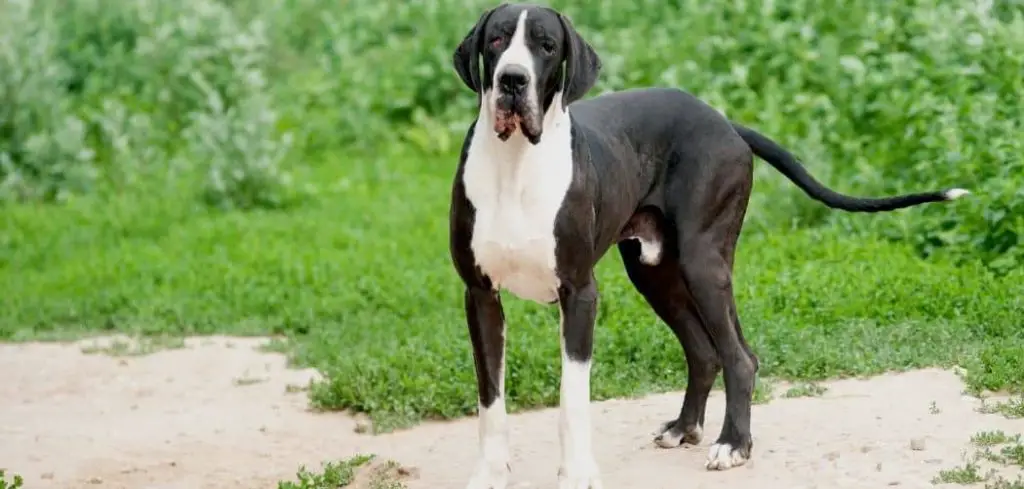Great Danes are majestic and loving giants, but their size also makes them prone to certain health issues that can affect their mobility.
If you’ve noticed that your Great Dane keeps falling, stumbling, or having trouble standing, it’s essential to identify the underlying cause and seek appropriate care.
We outline the reasons behind this issue, how to prevent falls, and what you can do to improve your dog’s quality of life.
Common Causes of Falling in Great Danes

1. Hip Dysplasia in Great Danes
Hip dysplasia is a common condition in large dog breeds, including Great Danes.
This genetic disorder occurs when the hip joint doesn’t develop properly, leading to instability and pain. Symptoms include:
Difficulty getting up
Wobbling or swaying while walking
Reluctance to exercise or climb stairs
Prevention & Management:
Provide a high-quality diet with joint supplements such as glucosamine and chondroitin.
Keep your dog at a healthy weight to reduce strain on the joints.
Consider low-impact exercises like swimming to maintain muscle strength without excessive stress on the joints.
Related: Great Dane limping (Explained)
2. Wobbler Syndrome in Great Danes
Wobbler Syndrome, also known as cervical spondylomyelopathy (CSM), is a neurological disorder that affects the spinal cord in the neck area.
It’s a leading cause of instability and falling in Great Danes.
Symptoms:
Unsteady gait, especially in the hind legs
Weakness or dragging of the paws
Neck pain and stiffness
Treatment Options:
Anti-inflammatory medications and pain relief
Physical therapy to strengthen supporting muscles
In severe cases, surgery may be required
3. Arthritis in Senior Great Danes
As Great Danes age, arthritis can set in, making movement painful and unsteady.
If your senior Great Dane keeps falling, arthritis could be the culprit.
Signs of Arthritis:
Reluctance to move or play
Stiffness, especially in the morning
Limping after exercise
How to Help:
Provide an orthopedic dog bed for joint support
Offer vet-approved pain medications and anti-inflammatory treatments
Use ramps instead of stairs to reduce strain on the joints
4. Vestibular Disease in Great Danes
The vestibular system controls balance and coordination.
If your Great Dane is suddenly falling over, tilting its head, or experiencing rapid eye movements (nystagmus), it could be suffering from vestibular disease.
Causes:
Ear infections
Inner ear problems
Neurological conditions
Treatment:
Veterinary examination to determine the cause
Antibiotics if an infection is present
Supportive care while the dog recovers
Related: Great Dane limping back leg (Explained)
5. Degenerative Myelopathy in Great Danes
Degenerative myelopathy (DM) is a progressive disease affecting the spinal cord, leading to weakness and loss of coordination in the hind legs.
Symptoms:
Dragging of the hind legs
Gradual loss of mobility
Difficulty standing
How to Manage:
Regular physical therapy to slow progression
Use of a dog wheelchair for mobility support
Proper nutrition and supplements to support nerve function
How to Prevent Falls in Great Danes
1. Maintain a Healthy Weight
Excess weight puts unnecessary strain on joints and increases the risk of mobility issues.
Ensure your Great Dane follows a balanced diet and gets regular exercise.
2. Provide a Non-Slip Environment
Slippery floors can make it difficult for your dog to walk, leading to falls. Consider:
Using area rugs or non-slip mats
Providing traction socks for better grip
Placing a yoga mat on hardwood floors
3. Regular Veterinary Checkups
Routine vet visits can help detect and address health problems before they become severe.
If your Great Dane suddenly starts falling, schedule a vet visit as soon as possible.
4. Use Supportive Gear
Dog harnesses, slings, and rear-lift harnesses can provide additional support for dogs struggling with mobility.
5. Strength Training and Low-Impact Exercise
Regular exercise helps maintain muscle mass and stability.
Swimming and controlled walking are excellent options for dogs with joint or spinal issues.
When to See a Vet
If your Great Dane keeps falling repeatedly, don’t ignore it. Seek veterinary attention if you notice:
Sudden loss of coordination
Inability to stand or move properly
Signs of pain, whimpering, or stiffness
Rapid weight loss or muscle atrophy
A veterinarian can conduct tests such as X-rays, MRIs, and neurological exams to determine the root cause and recommend an effective treatment plan.
Key Takeaway
A Great Dane that keeps falling isn’t just clumsy—it’s a sign that something may be wrong.
From hip dysplasia to neurological conditions, identifying the cause early can make a huge difference in your dog’s well-being.
With proper care, supportive tools, and veterinary guidance, you can help your gentle giant maintain stability and enjoy a happy active life.
